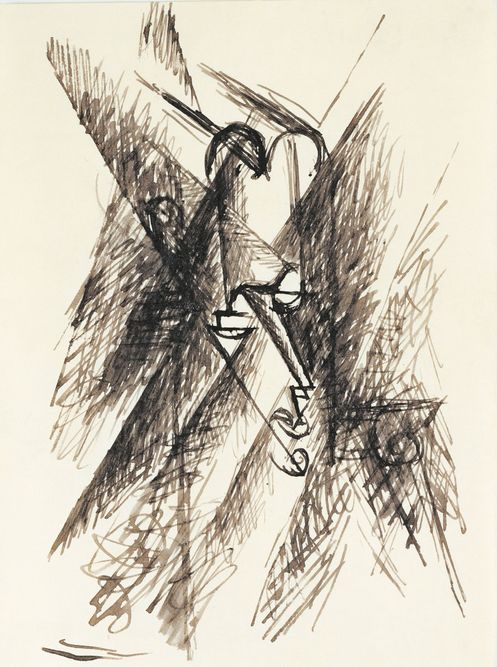‘Frank Burty Haviland was a friend, collector and admirer of Picasso’s – and a cubist painter himself. In 1911 Picasso summered near the monastery in Céret that Burty (as he was known to friends) had purchased the year before, and entered a period of work and dialogue with several painters, the most important being Georges Braque. As Picasso wrote to Daniel-Henry Kahnweiler, “Our friends” ideas are truly amusing […] I think that Braque is very happy to be here […] he already has a lot of ideas in mind.” [1] Indeed, that summer in Céret represented a watershed in the development of Cubism: for the art historian T.J. Clark, it was in the relative calm of Céret that Picasso and Braque together elaborated Cubism as “a hypothetically complete and alternative system of representation.” [2]
This small drawing of Burty, done in ink on paper, can be seen in relation to the great trilogy of portraits Picasso made in the fall of 1910 of his major collectors and dealers, Daniel-Henry Kahnweiler, Ambroise Vollard and Wilhelm Uhde. In these works the artist sought to secure the continued support of his closest associates while using their faces as the pretext for rigorous formal experimentation. It is quite possible that Picasso likewise began this sketch as a gesture of gratitude to Burty, who was the first owner of several of Picasso’s most important works, including The Actor (1904-5, Metropolitan Museum of Art, New York) and the Factory at Horta (1909, The State Hermitage Museum, St Petersburg). Most importantly, however, in these portraits, each sitter is reduced to a set of distinctive signs set into a progressively abstract context: Kahnweiler was identified by his moustache and pocket watch, Vollard by his domed forehead and beard, and Uhde by his crisp collar, sharp eyes and asterisk-shaped mouth. Burty’s identity, likewise, is indicated by two parallel cylinders of hair, sharp nose and a twisted mouth. These details, in particular the twin crest of hair, can also be seen in contemporaneous photographs of Burty and in portraits of him executed by Picasso’s peers, including Modigliani and Manolo Hugué.
Regarding the predominance of portraiture throughout Picasso’s career, the art historian William Rubin commented: “By redefining the portrait as a record of the artist’s personal responses to the subject, Picasso transformed it from a purportedly objective document into a frankly subjective one. Picasso’s portraiture casts the very concept of identity into doubt; it is no longer fixed, but mutable. Caught in the flux of the artist’s passion for metamorphosis, the images and identities of his real-life subjects continuously dissolve and re-form.” [3] At no point in his career was portraiture submitted to such intense pressure as it was in Cubism. Even as Picasso boiled down his sitters’ selfhood into a series of token signs, Rubin reminds us that his art also emphasised the contingency of identity, subjecting it to flux, alteration and metamorphosis’. [4]
[1] RUBIN, William. Picasso and Braque: Pioneering Cubism. New York: Museum of Modern Art, 1989, p. 377.
[2] CLARK, Timothy J. Farewell to an Idea: Episodes from a History of Modernism. New Haven: Yale University Press, 1999, p. 213.
[3] RUBIN, William. Picasso and Portraiture: Representation and Transformation. New York, Museum of Modern Art, 1996, p. 13.
[4] Trevor Stark in: LEBRERO STALS, José. Pablo Picasso: New Collection 2017-2020. Malaga: Museo Picasso Málaga, 2017, pp. 110-111.






